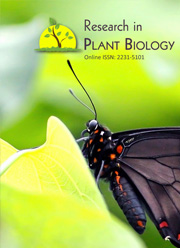Impact of NaCl stress on the physiology of four cultivars of S. lycopersicum
Keywords:
Tomato, Genotypes, Salt stress, Salt tolerance, NaCl, Ions.Abstract
To evaluate the genotypic variation of salt stress response in tomato, some morphological/physiological analyses were conducted on four tomato genotypes Pusa Ruby (PR), Punjab Keshari (PK), Ailsa Craig (AC) and Roma (RM). Some predictive screening parameters were set and applied at an early stage of the growth of the tomato plants. Four tomato cultivars were grown in 0.5xMS with different concentration of NaCl (0, 50, 100, 150 and 200mM). 24-day period of salt stress was applied on 15-day old plants. Morphologic and physiologic changes were determined depending on increasing NaCl concentrations. The genotypes exhibited different responses in terms of plant growth, particularly root/shoot growth, FW/DW (Fresh- Weight/Dry-Weight), accumulation of Na+, K+, Ca2+ and Mg2+. K+/Na+ and Ca2+/Na+ ratios were investigated. It was observed that, more K+ or Ca2+ absorbing plant with high K+/Na+ and Ca2+/Na+ ratios show better resistance to salt stress. As evidenced, PK appeared to be the most tolerant genotype while RM was the most sensitive one. AC and PR exhibited intermediary behaviours, suggesting the importance of making use of genetic variability. The research was conducted in a completely randomized design with three replications.



 .
. 